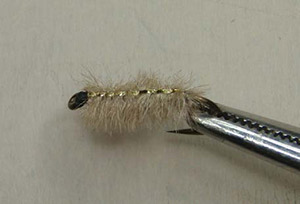RAY CHARLES
Aquatic sow bug – A crustacean, not an insect and trout nibble at sow bugs whenever they get a chance. Though they’re not often selective to them, they’re certainly aware of them, and almost always willing to take an imitation if even a few of the naturals are available. Since approxi- mately 130 species of aquatic sow bugs live in North America, trout get those chances almost everywhere that you might find them. Aquatic sow bugs feed primarily on decaying vegetation. Their numbers will be greatest in still or slow- flowing water with marl bottoms, in watercress beds, or in the thick sort of bottom vegetation that is often called moss. They will be absent or of little importance in freestone streams with brisk currents and clean bottom stones.
Sow bugs do not emerge and they have hard shells, usually grey, flattened and a bit wider at the butt than at the head. They have two pairs of antennae in front with a small “v” shape at the end of each, a pair of legs that extends off each of seven thoracic segments, and a pair of forked tail- like members. It should be rigged to get them on or near the bottom. Use an indicator about the depth of the water.
PATTERN
HOOK – Size # 14 - 20 2x long nymph or 2x heavy curved scud. Mustad #R72 or Tiemco # 5262. THREAD – Black 8/0
RIB – Fine silver wire SHELLBACK – Gold Mylar
BODY – Gray ostrich hurl (long ones if you can) SOFT HACKLE – (Optional) Light blue dun henHOW TO TIE
- Debarb- mount hook – start thread about halfway on the shank and go to just before the bend of the hook and tie in your wire. Then tie in your gold Mylar (If you have the kind with silver on one side and gold on the other tie it in with the silver side up and it will flip over to gold when bringing it forward).
- Tie in a couple of ostrich hurls (The longer the better) by the butt ends. Then bring your thread forward to just behind the eye of the hook.
- Wrap your hurl forward (Don’t make a rope with the thread – it lays the hurl down flat in spots) to just about an eyelets space behind the eye – if you come up on the hurl just tie in a couple more but remember you want a taper (fatter in the rear – thinner in the front) so tie in with the middle of the hurl instead of the butt end. Half hitch it to secure.
- Pet the top of the hurl down to the sides and bring your Mylar forward over the top and tie off in the front near the eyelet.
- Spiral wrap your wire forward. Just remember you need seven segments and the tie off, whip finish and you’re done.
- (Optional) Tie in a light blue dun hen feather and make a soft hackle collar by wrapping the feather two or three close wraps then tie off and using your thread do a few wraps over the front feather while petting the feather barbs backward which lays it backward. Whip finish and you’re done.
You can also tie this in brown-tan-black and even in pink. But the it would be more of an egg pattern than a sow bug.


